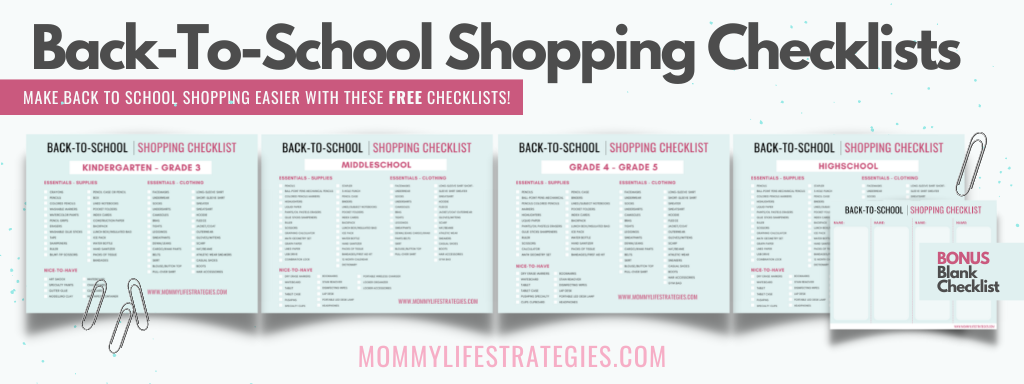
As a parent, you might be dreading the back-to-school shopping or maybe you can’t wait to drop some hard cash on cool gear for your kids.
I can understand both sides because school shopping can be stressful and easy to spend more than you need if you’re not careful. But you want your kids to have the best so it’s tempting to buy all the things.
I get it. That’s why it’s never a good idea to wait last minute to go shopping for back to school. I’ve compiled an essentials shopping list by age group so you can stay on track.
I’ve also included some nice-to-haves as an option if you have the budget for it, as well as some tips and reminders to save money and track spending.
Grab my Free School Shopping checklists before you head to the store. There are checklists for Elementary, Middle and Highschool levels as well as a blank shopping checklist you can fill what you want.
Each checklist has a list of essentials for school supplies and clothing. There is also a nice-to-have category where some of these items might not be necessary for your kids. The nice-to-haves are items you they might need but can wait until they absolutely need it and/or if it can fit in your budget.
Got your checklists? Great! Now, let’s talk smart school shopping and budgeting.
This post contains Amazon affiliate links. An affiliate link means at no extra cost to you, I earn a commission if you make a purchase through my link. Please read my Disclaimer for more details.

Shop essentials first
Before you buy supplies, check with your school to see if they will provide some basic supplies. Every school will be different so make sure to find out what they have first to avoid buying what you don’t need.
Clothing is a personal choice so I won’t suggest a style, fit, or tell you what the exact amount of clothing for each clothing type you should have. Ideally, you would want enough pieces to get your kids through the week.
Consider what your child’s current clothing turnover as well as what kind of clothes they prefer to wear in general. Get their feedback and decide on a reasonable amount of clothing.
Keep reading for tips on how to save on school supplies, clothing and gear.

Setting a budget for back-to-school
Back-to-school costs can be significant, that’s why it can be such a stressful time of year.
The best way to stick to a budget and shop smart is to set a budget and make a shopping list. Focus on essentials and priorities first.
You can use an excel sheet, printed budget sheet or an online calculator like this one to determine the costs for school supplies, clothes, and other gear.
After you make your list, decide what is a need and what is a nice-to-have. Before you even head to the shops, create your list and review it. You are less likely to buy extras if you have a list to follow and are less likely to overspend.
The time spent in-store matters too. Limit your time in the store to prevent yourself from giving into all the tempting merchandise.
Online shopping is a great option as it’s usually easy to compare products, place an order and can be delivered fast. Impulse shopping is more likely in-store versus online. It’s still a good idea to be mindful of impulse shopping in any case, so going into your shopping trip with this awareness can help you stick to your list and budget.
After you buy your essentials first, you know what’s left over in the budget which can be saved for an unexpected school cost down the road or a nice-to-have item.
Check with your child’s school to get a list of what back to school items are necessary. They usually provide parents with a list, but you can always ask the school for one.
Waiting until they start school for nice-to-have items can give you a better idea if they are needed or not.
Ask yourself if you really need to buy new. Not all shopping needs to be for brand new stuff. Take advantage of online marketplaces that sell gently used or refurbished goods. Many are items still with tags or never used but at used prices.
Tips to save money on back-to-school shopping
1.Store brands vs. Name Brands. Store brands have gotten better over the years, and most are comparable to name brands. If your child is not set on a name brand, choose the more affordable store brand. If your child is brand sensitive, you can compromise and offer to pay a portion and they pay for the rest with from their allowance or gift money.
It teaches them some good lessons here too. They can learn the difference between a want and a need. Paying for some items themselves can help them manage their money and understand when it’s worth saving than spending.
2.Consider thrifting. Thrift stores and consignment shops. Kids grow so fast and it’s not unusual for a child go from one size to another in a couple of months. Growths spurts can be hard on the budget, so take that into account. Consider thrift and consignment shops for some if not most of your shopping needs. Thrifting in store or online marketplaces can help save money during these growth spurts.
3.Check with friends and family members to do a supplies exchange or swap. They might even have extras they don’t want and are willing to part with. There will always be someone who buys more than they need!
4.Scan online for coupons, discounts and cash back offers. I’m not a big fan of coupon clipping and hate carrying around a wad of expired coupons in my wallet. Many coupons have restrictions making them unusable and are usually only good for a limited time. Save yourself the fuss and look online for offers with companies or apps like Rakuten.
There are apps where you can scan your receipt and get cash back. Loyalty programs are popular and available at many retail shops and department stores. Take advantage of these paper-free and hassle-free offers to save money, get cheap or free stuff.
Be careful of contest and survey websites. Some are spammy, costing you your time and energy for very little in return.
5.Get your kids involved with the budgeting. They can participate in writing out the costs of items from the list and comparing it with your budget. This will give them a clear visual of how much money is being spent and what will be left over. This is an opportunity to express to your child that spending more can mean less for them. Teaching them to be a perceptive shopper will not only help them now but develop them to be a smart shopper as adults.
6.Encourage a healthy money mindset for your kids. Read books, watch videos of kids like them saving and investing their money. They can see that it’s not just grown-ups that do it, but kids can take control of their money too.
7.Offer an incentive if they stay under budget. This can be really motivating for kids and the offer can be cash, a nice-to-have back to school item, or money put in their savings account for a special purchase in the future.
8.Plan a no-spend month after back-to-school shopping is done. This one isn’t easy but worth it. It can be any month you choose. I understand fall and winter holidays are fast approaching so you might be wondering how you can pull that off. Choose a month in the year that you don’t have many events like big holidays like Christmas.
No-spend does not mean no spending on food or emergencies, it’s about not spending on the nice-to-haves or unnecessary purchases that can really add up at the end of the year. Give it try and get creative. It might turn out it wasn’t as bad as you thought it would be.
School shopping doesn’t have to be stressful. Plan ahead, create a budget, make a shopping list (or use my free shopping checklists), and look for ways to save as much as possible.
After the first day or week of school, you and your kids will have a better idea of what additional costs are needed for the school year.
Do you have any back-to-school shopping and budgeting tips you want to share? Let us know in the comments.


